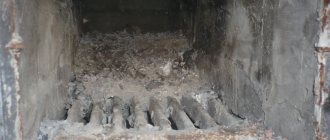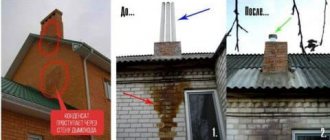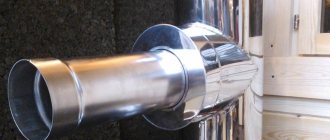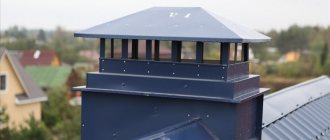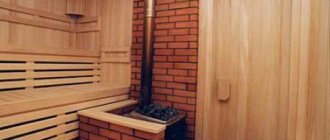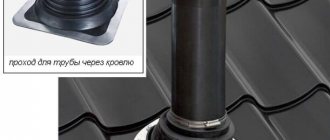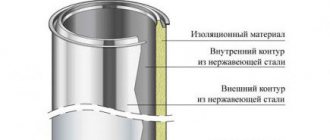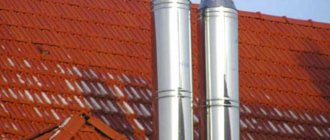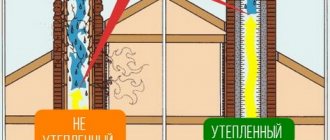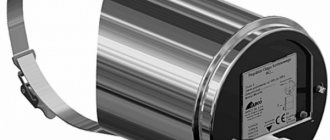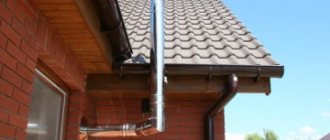Possible problems and ways to solve them
A wooden house is subject to shrinkage, so previously the chimney was mounted in a special shaft, standing separately from the main building. Today this approach is not relevant. According to the rules, an individual chimney is supplied to each heating device. It is important to comply with the standards for their height above the roof level. However, these standards only apply if the firebox is open.
The gas exhaust system is pre-designed: a wooden house is a fire-hazardous structure, so all the features of the structure are taken into account. Engineers provide design documentation on the basis of which the smoke exhaust system is installed.
Installation features
According to state rules. The standard chimney is made only of glossy brick. Its location can only be vertical; deviations from the axis are not allowed. A wooden house must be protected from possible overheating of the roof base, so the pipe must be more than 5 meters. The distance is measured from the grate.
It is not easy to build a chimney with your own hands. It is important to take into account the installation features. Depending on the type of roof, the height of the pipe is calculated. Photos of some typical solutions are presented in this article. If the roof is flat, then the pipe rises 50 cm. If there is a ridge, then the distance is measured from it. The chimney should be located at some distance from the ridge, and it is important to comply with all recommended parameters. A wooden house will last for many years with the right approach to the installation of heating equipment.
Requirements for chimneys
- Installation of gas and other heating equipment must occur in accordance with the rules for installing a chimney.
- The correct selection of chimney parameters (height, cross-section) must be observed, which must meet the requirements of the installed heat-generating equipment, because its operation will depend on this.
- Installation work must be carried out by specialists in compliance with all fire safety requirements and in accordance with regulatory documentation (see Installation of chimneys).
Requirements for chimneys
- The recommendations provided by the manufacturer must be followed.
- The diameter of the chimney channel should be chosen the same or larger than that of the unit itself; the height of the pipe is indicated in the instructions. Unless specified by the manufacturer, the minimum chimney height must be at least 5 meters.
- In accordance with NPB-98, in the channel itself the flow air speed should be in the range of 15 - 20 meters per second.
General rules
Depending on the conditions of use, chimneys may have different designs. Its uninterrupted operation and efficiency depend on the quality of the chimney and its material.
Their installation is carried out in accordance with the requirements set out in DBN V.2.5-20-2001 and SNiP 2.04.05–91.
Improper design and use, improper connection to thermal equipment may lead to improper operation and accident.
This manual describes the principles of operation and installation of chimneys, sets out fire safety requirements, which are reflected in the documentation.
- SNiP 41-01-2003 - “Air conditioning, ventilation, heating”;
- NPB 252–98 - “Heat generating devices that operate on different types of fuel. Test Methodology";
- GOST 9817–95 - “Household appliances that operate on various types of fuel. Technical conditions";
- VDPO - “Rules for production work, repair of smoke ducts and furnaces.”
SNIP chimneys must comply in full. After commissioning of the chimney, a chimney inspection report is issued.
Installation rules read:
- It is necessary to completely and freely exhaust exhaust gases into the atmosphere; draft is ensured by the correctly selected height and cross-section of the pipe (clause 5.1.1.VDPO).
- Each heating device must have a separate chimney (clause 3.70.SNiP-91).
- The diameter of the chimney must be no less than the outlet of the heating unit pipe (3.71.SNiP-91).
- The thickness of metal pipes must be at least 0.5 mm. They must be made of alloyed special steel with increased corrosion resistance (GOST).
- To clean combustion products, pockets with a depth of 250 mm must be provided in the smoke ducts. — (clause 3.74 of SNiP-91 and clause 5.1.1.VDPO).
- Smoke channels cannot have more than 3 turns, and their radius of curvature cannot be less than the diameter of the pipe - (4.2.17.VDPO).
- The chimney cannot be lower than 5 meters in height (clause 3.73.SNiP-91). This height provides the required thrust and gives the required resolution. In this case, the height of the exhaust ventilation ducts, which are located next to the chimney, must be equal to the height of the pipes (5.1.14.VDPO).
- The elevation of chimneys above the roof should be done (clause 3.73.SNiP-91):
- up to 500 mm if the roof is flat;
- up to 500 mm above the parapet or roof, if the pipes are located less than 1.5 m to the parapet or ridge;
- not less than the axis of the ridge or parapet, if the chimney is located on 1.5 - 3 meters from the parapet or ridge.
Pipe height above roof
- Installation of all elements is carried out from below (from the generating apparatus itself) and proceeds upward. Installation of pipes is carried out by inserting a pipe into the previous one. To enhance sealing, sealants are used in the work; their operating temperature must be at least 1000º (clause 5.3. GOST). Pipes and other elements used must be connected with clamps; the connections must not fall into the cross-section of the ceiling. Every two meters of the chimney, a bracket should be installed to the wall; the tee should be secured with a support bracket. All chimney elements are also attached to the building structure with brackets. Deflection of the structure is excluded (4.2.14.VDPO).
The rules for installing chimneys say that placing smoke ducts is allowed inside walls made of non-combustible materials. If there are no such walls, it is required to use crown and cap pipes (clause 3.69.SNiP-91).
Sections of the chimney passing through unheated rooms and on the outside of the building must be thermally insulated so that condensation of thermal vapor and flue gas does not occur in the inside of the chimney (4.2.16.VDPO).
According to the requirements of VDPO and SNiP-91, the following chimney options are allowed:
- With modular chimney systems it is prohibited:
- Melting with flammable liquids.
- Melting with wood larger than the size of the firebox itself.
- Drying clothes, shoes and other items on chimney parts.
- Removing soot by burning.
- It is prohibited to operate the unit using a method not specified in the manual.
- Pouring water onto the fire in the firebox.
- Use chlorine for its compounds.
Chimneys must be inspected by a qualified specialist at least twice during the heating season. To ensure the operation of the heating unit, chimneys should be inspected, and this should be done by specialists.
- When two boilers are connected to the chimney, the cross-section of the pipe is determined by their joint operation DBN V.2.5-20-2001 (Appendix G, Clause No. 6). The dimensions of chimneys are determined by calculation, which is indicated in the technical documentation.
- Gas appliances for non-domestic purposes (digesters, restaurant equipment) are allowed to be connected to common chimneys.
- Installation of smoke exhaust pipes with an exit through one is allowed, but an additional calculation of the pipe cross-section must be made.
- The release of exhaust gases for several devices is allowed. The calculation must be made at different levels, according to DBN V.2.5-20-2001 (Appendix G, Clause No. 3).
- The cross-section and height of the chimney is determined taking into account the operation of all devices simultaneously, DBN V.2.5-20-2001.
Chimneys made in accordance with SNIP work efficiently and do not contradict legal standards.
About current approaches
If there is a fireplace in the room, then the Sandwich technology is the most relevant. Do-it-yourself installation is not complicated by “wise” decisions. The chimney consists of an inner pipe made of stainless steel and coated with a ceramic layer; mineral wool necessary for thermal insulation; sealant and fixatives. To better understand the features of the Sandwich design, it is recommended to look at the photo.
Installation is also carried out according to the “plastic stocking” principle. This technology is used mainly when the pipeline is bent. A house can be built not only according to standard designs, but also using original solutions. Then a plastic stocking can become simply irreplaceable. It should be remembered that such a chimney cools quickly, but also heats up quickly.
If the pipe is routed through a wall, the exit point is insulated with a special non-flammable material (mainly foam concrete). All this is hidden under the finishing panels. A protective collar is installed at the exit points, which increases waterproofing.
Sandwich chimney installation
Scheme
When choosing a chimney placement option, two main schemes are usually considered: internal installation with passages through the ceilings and roof, and external installation, with passage through the wall and installation on the outside of the building wall.
External installation
Internal installation
When the chimney is placed internally, it is less susceptible to external influences, and the formation of condensation is practically reduced to zero.
This option is appropriate, for example, for a sauna stove, since it is possible to install a tank for heating water on the initial section of the pipe (before inserting into the sandwich structure), as shown in the figure, or a mesh section for laying the heater.
About cladding
At the construction stage, do not forget about the pipe lining. The house will look better if the chimney is made in an antique style. Some masters recommend applying 3 mm. cement plaster. For greater durability, it is coated with silicone paint.
The cladding is also done using clinker bricks. Its advantage is that it is resistant to harmful influences. As an alternative, clinker tiles are chosen - they are lighter than bricks. They lay it in a checkerboard pattern. The cladding made of natural stone looks good. It is fixed with glue; it is important that the thickness of the layer is not more than 1 cm.
If bitumen shingles are chosen as a facing material, then it is necessary to take into account a number of nuances during installation. It can only be installed at temperatures below 25°C. There should be no wind.
Briefly about the main thing
It is not always easy to solve the problem of installing a chimney when installing a stove in a wooden house. Today there are a number of rules and regulations, failure to comply with which may result in fines and other government sanctions. Before starting construction, you should consult with specialists.
has been designing and installing smoke removal systems for many years. Among the projects completed by our company, a considerable part is related to the installation of chimneys in wooden houses.
Specifics of installing chimneys in wooden houses
A house made of wood is a very environmentally friendly and pleasant house for permanent residence, but making an effective and safe heating system in it is not an easy task. It's all about the flammability of wood: any contact with a heated heating unit or chimney element can lead to a fire. This means that when designing heating and smoke removal systems it is necessary to pay maximum attention to thermal insulation issues.
Main document
The basic requirements for chimneys installed in houses are described in SNiP 41-01-2003 “Heating, ventilation and air conditioning”. This document notes in particular that:
- the minimum distance between structures made of flammable materials and brick pipes or ceramic pipes with thermal insulation should be 130 mm;
- The minimum distance between flammable elements and ceramic pipes without thermal insulation must be 250 mm.
When installing chimneys in wooden houses, these standards must be strictly observed.
Requirements for the installation of chimneys
In order to prevent fires in wooden building structures, chimneys in a wooden house must be located at a certain distance from elements made of flammable materials:
- If the chimney pipe is made of ceramic material that does not have thermal insulation, the minimum distance must be 25 centimeters,
- If the chimney is made of concrete or brick, the distance can be reduced to 15 centimeters.
Please note that not only wooden structures, but also many finishing materials made from synthetic materials can easily ignite. Thus, vapor barrier films pose a danger.
chimney passage through a wooden ceiling
Choosing a chimney type
The choice of material and design of the chimney is determined by the architecture of the house, as well as the characteristics of the heating units that will be connected to the smoke removal system. So, for example, the temperature of the flue gases of a pellet boiler rarely exceeds 250 degrees, and the temperature of the flue gases of a coal-fired boiler can reach 700 degrees Celsius. Obviously, much more stringent requirements are imposed on the chimney for a coal boiler.
Brick chimneys
Brick chimneys are common in older homes, where the stove and chimney were often built before the building itself. Today, brick is not so popular, but many homeowners choose it.
Advantages of brick chimneys:
- high mechanical strength;
- relative durability;
- attractive appearance.
Disadvantages of brick chimneys:
- heavy weight;
- rectangular cross-section (imperfect from the point of view of traction force);
- rough surface;
- sensitive to strong acids and aggressive chemical compounds;
- complexity of installation and maintenance.
For the installation of chimneys, red solid brick is used. Masonry inside the house is done using lime or cement-lime mortars. For laying bricks above the roof level, only waterproof cement mortar is suitable.
Ceramic chimneys
Ceramic chimneys are an excellent alternative to bulky brick structures and rather short-lived chimneys made of sheet steel. They are widely used in modern houses made of rounded logs, timber and other wood materials.
Advantages of ceramic chimneys
- mechanical strength;
- good traction;
- ease of installation;
- Possibility of installation both inside and outside the building;
- resistance to aggressive compounds;
- resistance to high temperatures (up to 1000 degrees);
- exceptional durability (manufacturers' warranties for many systems are 30 years or more);
- high-quality thermal insulation.
The latter should be mentioned separately. In the vast majority of cases, ceramic chimneys have a three-component structure. Each element includes a piece of ceramic pipe with a smooth inner surface, thermal insulation mats and a lightweight concrete box. Thus, even when very hot fuel gases pass through, the outer concrete casing practically does not heat up. This is very important for installing chimneys in wooden houses.
Ceramic smoke exhaust systems have only one drawback - high price.
Metal chimneys
There are one-component and two-component metal chimneys.
Single-piece chimneys consist of simple steel pipes with a circular cross-section. This is the cheapest solution, but it has many disadvantages:
- low durability;
- large heat losses;
- impossibility of external installation;
- the need to create complex and expensive thermal insulation.
The latter is especially important in the case of wooden houses. Thermal insulation is used literally everywhere where even the slightest heating is possible. This applies to any chimney, but in the case of thin steel pipes it is especially important.
A two-component chimney (steel sandwich chimney) has its own thermal insulation layer, which is located between two steel pipes. This is a more expensive, durable and safer option. Such a chimney can also be used for external installation, which allows you not to go through all the floors and roofs, but to make one passage through the wall at the installation point of the heating unit ().
Installation of a sandwich chimney. Recommendations from experts
Sandwich pipes for a chimney are a structure of two pipes nested one inside the other. The gap is filled with heat-insulating material with fire-resistant characteristics. Stone wool is most often used as insulation. The thickness of the layer affects the thermal stability of the entire structure and varies from 3 to 10 cm.
The pipes are made of stainless steel. Galvanized material can only be used when using wall-mounted gas boilers and low-power water heaters.
The thickness of stainless steel varies from 0.5 to 1 mm. The grade of stainless steel is chosen depending on its purpose.
| Brand AISI | Application | Characteristics |
| 430 | For external casings of sandwich pipes | Belongs to economy class. It reacts poorly to elevated temperatures and has sufficient resistance to atmospheric influences. |
| 439 | As an air exhaust from gas boilers and solid fuel installations with a power of up to 30 kW. | The composition includes titanium, which increases thermal stability and resistance to aggressive environments. |
| 316 | The best option for any type of gas boilers. | The composition includes molybdenum and nickel, which increase resistance to acids and high temperatures. |
| 304 | For boilers of low and medium power. | They contain a small amount of nickel and molybdenum. Refers to the economy version of the AISI 316 brand. |
We invite you to familiarize yourself with an iron stove with a brick chimney
The internal diameter of the pipe must be the same as the cross-section of the outlet pipe, or wider. If the chimney pipes are wider than the pipe coming out of the boiler, an adapter is installed at the junction.
| № | Internal section | Boiler power |
| 1 | 8 cm | Up to 3.5 kW |
| 2 | 9.5-11 cm | 3.5-5.2 kW |
| 3 | 11 cm or more | More than 5.2 kW |
In one article it is quite difficult to pay broad attention to such a topic as the construction of an external chimney. Firstly, it has many nuances, and, secondly, such an article will be incredibly large and inconvenient to read.
That is why I will now give only a general overview, and I will address all questions on individual points that you have in separate publications. Although today there is already material on a similar topic. So, the outer pipe can be made of several materials.
- Let's start with the brick output.
Such arrangement of the hood will become as convenient as possible for people who want to organize a fireplace in their home. After all, this design is considered the most optimal for a fireplace. Although, it may be suitable for a bathhouse (it all depends on your capabilities and desires). But it is worth noting that it requires certain skills to install it correctly (which we will talk about in other articles).
- An ordinary stainless steel pipe.
The simplest and most cost-effective option for organizing this type of chimney. After all, the main difficulty in its manufacture will be making a hole in the wall for the outlet pipe. But there are certain difficulties here, namely the need for external insulation (especially in low temperature conditions). After all, its absence will significantly affect the draft due to excessive accumulation of condensate. The stove simply does not want to be heated and will smoke heavily.
In fact, this is an ideal option for installing an external chimney, both in a bathhouse and in a wooden house. Consisting of two sleeves placed inside each other, between which factory thermal insulation is already provided, such a pipe is extremely easy to install and efficient in operation. It is for this reason that I would recommend using it when installing a chimney through a wall in your room.
It can withstand the highest temperatures, but at the same time requires the most complex installation and insulation. In addition, it is distinguished by its rather high cost and relative fragility.
To bring the pipe outside with your own hands, it is necessary to provide for its insulation. The situation here is similar to the insulation of a chimney when passing through a cold attic and after exiting to the roof. Installation of thermal insulation can be carried out using various materials.
Thermal insulation using mineral wool
Mineral wool is easy to install and does not burn. There are special elements on the market for pipe insulation that will greatly facilitate the work. If you want to save money, it is better to choose glass wool in mats (rolls). Characterized by high efficiency. You can choose a material that is suitable in thickness and density.
Basalt pressed cardboard is a durable material that can withstand up to 2000 heating and cooling cycles. Basalt fiber does not burn. Positive aspects will also be low cost and the ability to withstand high temperatures.
Asbestos fabric is common in our country to meet fire regulations, but is not used in Western countries due to its carcinogen content. When used in external chimneys, human contact with asbestos is minimal, so the material does not pose a danger.
Installation of insulation for brick pipes is carried out in the same way as thermal insulation of external walls. For metal chimneys there are two options. The first is the simplest - buying sandwich type pipes. The design already includes insulation and consists of an outer and inner pipe. The second option is to make an outer casing from stainless steel and lay effective insulation between it and the chimney. The easiest way in this case is to use mineral wool. The thickness of the thermal insulation is taken to be no more than 10 cm.
One of the most important issues here is sufficient insulation of the pipe.
When designing this stage of work, a large number of factors should be taken into account, including:
- Wall structure;
- Materials used;
- Pipe exit location;
- Diameter of the chimney opening.
Options for venting the chimney through the wall
